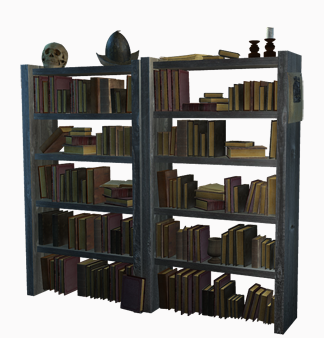Object Descriptions Tower House Study
Bookshelves
It is unclear how large of a library Spenser had. Like the “Library” of Eumnestes in The Faerie Queene (II.ix.59.3), it may have been large and full of worm-holes, or small and well-cared for, or anywhere in between. It is hard to imagine Spenser writing The Faerie Queene and whatever else at Kilcolman without some recourse to books and manuscripts at hand, either in his own house or nearby at places like Mallow, the estate with large castle owned by the Norris family, who served as Presidents of Munster. Mallow was a long way to walk, however, to check up on a quotation (see Trade and Travel: Roads).
Andrew Hadfield estimates that Spenser had 200-300 volumes in his working library (by comparison, an inventory of Munster planter Sir William Herbert’s seignory at Castleisland, Co. Kerry mentions “of sundry sortes great and little one hundred“ books). These would have been in various languages and of all kinds and genres, ranging from religious to legal tracts to popular and refined works of literature.

The space for the conjectured study in our recreation is relatively small, so vertically stacked bookshelves (a design known in the late-sixteenth century) are used instead of shelves angled outwards from the wall (as one might find in a periodicals reading-room today, for example). The latter type were better for displaying the covers of books but the former could hold more. Contrary to modern-day practice, the majority of the books are arranged with their spines facing the wall. The reason for this is that many books were bound haphazardly by the owners, and titles of books were often written in ink on the page-ends of books, as opposed to being stamped onto the leather or vellum of the spines.
There was a book trade in early modern Ireland, but how far it reached into the countryside is uncertain. Spenser travelled enough, including to London, and spent enough time in major Irish towns, such as Dublin, and earned enough money, to have amassed a good collection of books for a person of his social status. Many of these books would presumably have been burnt when the castle went up in flames in 1598. Losses may have included unpublished parts of The Faerie Queene.
On the top shelf of one of the bookshelves are two objects with threatening significance. One, a skull, is the standard medieval momento mori or reminder of our final end. The other is a Spanish helmet (see Tower House Study: Helmet), the sort of trophy that Spenser could have bought or have picked up as a souvenir after one or another expedition by Spain landed on Irish shores (disastrously so).
Spenser was a poet acutely conscious of worldly ruin and of his own mortality, while simultaneously hopeful that a decisive English Protestant victory over Spain (and other foreign Catholic forces) might finally be achieved. Spenser anticipates such a battle in The Faerie Queene, between “that great faery Queene and Paynim king,” which he promises to one day write about (FQ I.xi.7). Spenser’s epic has a godly, anti-Spanish, anti-papal, pro-English militaristic purpose. Ironically, that battle came to Kilcolman too soon, and his book was never finished.
Bibliography:
Raymond Gillespie and Andrew Hadfield (eds), The Oxford History of the Irish Book: Vol. III: the Irish Book in English, 1550-1800 (Oxford: Oxford UP, 2006).
Andrew Hadfield, Edmund Spenser: A Life (Oxford: Oxford UP, 2012): 226-30.
A. Kent Hieatt, “The Projected Continuation of The Faerie Queene: Rome Delivered?” Spenser Studies 8 (1987), 335-42.
Rev. Kieran O’Shea, “A Castleisland Inventory, 1590.” Journal of the Kerry Archaeological and Historical Society 15-16 (1982-3), 37-46.
David Wilson-Okamura, “When Did Spenser Read Tasso?” Spenser Studies 23 (2008), 277-82.